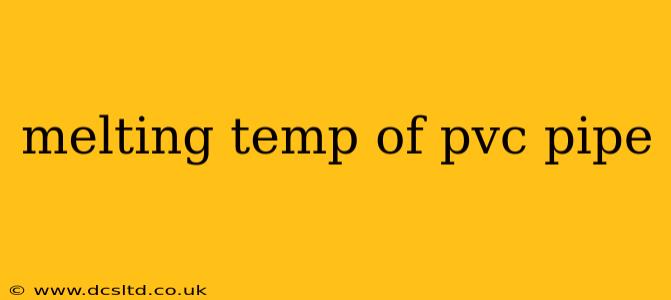Polyvinyl chloride (PVC) pipe is a ubiquitous material used in various applications due to its durability, cost-effectiveness, and resistance to corrosion. Understanding its melting point is crucial for safe handling, processing, and predicting its behavior under different conditions. However, it's important to note that there isn't one single melting temperature for PVC pipe. The exact temperature at which PVC softens and eventually melts depends on several factors. This comprehensive guide will delve into the specifics, answering common questions surrounding the melting temperature of PVC pipe.
What is the melting point of PVC pipe?
There's no single definitive melting point for PVC pipe. Instead, PVC undergoes a softening process over a temperature range. Generally, PVC pipe begins to soften around 130-150°C (266-302°F). However, complete melting typically occurs at temperatures exceeding 175-180°C (347-356°F). These temperatures can vary depending on several factors including:
- Additives: PVC pipe isn't pure PVC. Manufacturers add various stabilizers, plasticizers, and other additives to enhance properties like flexibility, durability, and UV resistance. These additives can significantly impact the softening and melting behavior of the material.
- Pipe Schedule: The schedule (thickness) of the PVC pipe influences its melting point. Thicker-walled pipes generally require higher temperatures to melt compared to thinner-walled pipes.
- Exposure Time: The duration of exposure to heat plays a critical role. Prolonged exposure to lower temperatures can eventually lead to softening and degradation, while brief exposure to higher temperatures might not cause significant melting.
Does PVC pipe have a specific softening point?
Yes, PVC pipe has a softening point, which is the temperature at which the material starts to lose its rigidity and becomes more pliable. This typically occurs in the range of 130-150°C (266-302°F), as previously mentioned. It's important to distinguish this from the melting point, where the material fully liquefies. The softening point is crucial for processes like pipe bending, where controlled heating is necessary to achieve the desired shape without completely melting the material.
What happens when PVC pipe melts?
When PVC pipe reaches its melting point, it transitions from a solid to a viscous liquid state. The exact appearance will depend on the additives present. It may become a gummy, sticky substance. Importantly, melting PVC releases toxic fumes, including hydrogen chloride (HCl) gas. Inhaling these fumes can be extremely dangerous, causing respiratory irritation and other health problems. Therefore, melting PVC pipe should only be undertaken in well-ventilated areas with appropriate safety precautions.
At what temperature does PVC pipe decompose?
While the melting point signifies the transition from solid to liquid, decomposition refers to the breakdown of the PVC molecular structure. This typically occurs at temperatures significantly higher than the melting point, often above 200°C (392°F). Decomposition releases harmful byproducts, including dioxins and furans, which are highly toxic and environmentally hazardous.
Can I safely melt PVC pipe at home?
No, melting PVC pipe at home is strongly discouraged due to the inherent risks involved. The release of toxic fumes presents a significant health hazard. Furthermore, improper handling could lead to accidental burns or fires. Proper disposal methods through recycling centers are always recommended. Only trained professionals with appropriate safety equipment and ventilation systems should handle PVC melting.
Conclusion
Understanding the melting temperature of PVC pipe is vital for safe handling and processing. It's crucial to remember that the softening and melting temperatures aren't fixed values, and vary based on several factors. Always prioritize safety and avoid attempting to melt PVC pipe without the proper knowledge, equipment, and safety precautions. Remember, the release of toxic fumes during melting presents a serious health risk. Responsible disposal methods are always preferred over attempting to melt the material at home.
